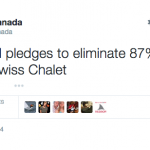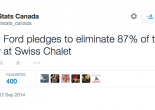Not Just for Laughs
Many articles on Canadian satirical news sites are fictional, but there’s still plenty of truth in them
Five writers gather in a dimly lit room on a Sunday evening. Black shutters and posters line the deep purple walls of the second floor of The Central, a Toronto bar. Classic rock bounces up from the deserted first floor and a faint smell of urine wafts from the nearby bathroom. Three writers sit around a chipped wooden table, the other two lounge on a grey couch. They all pitch headlines.
Editorial meetings for The Beaverton, a Canadian satirical news site, are about headlines, not story ideas. Editor-in-chief Luke Gordon Field reads from his laptop: “Conservatives unveil last minute attack ad accusing Justin of supporting Kansas City.” The old radiator by the window gurgles to life as the writers snicker.
“Like he was seen wearing a blue hat.”
“And Kansas City has blue uniforms…”
“But it was really a Blue Jays hat.”
Laughter means everyone likes the idea. Field will write the story later that night. The others read headlines they’ve prepared, but the Kansas City story is one of the few that gets the go-ahead. The joke doesn’t really need explaining.
To Field, the perfect headline is equal parts funny and attention-grabbing, sometimes provocative and reveals something true about Canada or society. He echoes what many other satirists believe: fake news can offer something traditional news or commentary can’t, won’t or shouldn’t. While journalists are confined to facts, satirists point out absurdities.
The Beaverton’s founding editor Laurent Noonan loved The Onion, but he couldn’t see a Canadian counterpart. So, in 2010, he decided to create one. He recruited writers, built a website and later created a print edition that he handed out to strangers on the street—while dressed in a beaver costume.
Field, a stand-up comedian, joined the writing team soon after and, in 2012, took over the editorial side when Noonan traveled to teach English in France. In December 2014, Noonan died and Field became the official editor-in-chief and the one in charge.
The Beaverton has gained a steady following over the past five years. In May 2013, a story about astronaut Chris Hadfield’s return from space, “Hadfield comes home to $1.37-million Rogers phone bill,” caught people’s attention and caused a spike in readership. A Hong Kong newspaper even reported the story as real news. By August 2015, the website averaged about 400,000 readers per month. In October, election coverage pushed those numbers up to 750,000.
While in the U.S. The Onion is the authoritative satirical outlet, Canadian outlets run on shoestring budgets and have trouble staying afloat long enough to establish themselves as the publication of record. Halifax’s Frank magazine launched in 1987 and became popular. Another version of the magazine, based in Ottawa, began publishing two years later. It shut down in 2004, reappeared and closed down yet again in 2008 in the face of online competitors. It resurfaced in 2013 using an online subscription model and print editions.
The Lapine and The Syrup Trap are two other fake news publications that began within a few years of The Beaverton. The Trap’s founder and editor-in-chief Nick Zarzycki finds it troubling that Canada doesn’t have a widely-read national humour publication because he believes satire is a vital part of any functioning democracy. Both publications cover politics in their own style, but not as frequently as The Beaverton.
During the federal election, Field’s site created fake platforms for each party and ran articles from the silly (“Justin Trudeau removed by mall security for walking up wrong escalator”) to the skewering (“Globe and Mail heroically defend country’s most vulnerable rich by endorsing Conservatives”). After the election, The Beaverton ran an article titled “50% female cabinet appointments lead to 5000% increase in guys who suddenly care about merit in cabinet.” Many journalists at traditional news outlets made the same point, but The Beaverton captured the argument in a single headline.
Canadian satire and parody researcher James Onusko sees an edge in much of the political coverage. While he acknowledges that some the site’s stories are silly, he appreciates its more hard-hitting material, such as questioning the integrity of political parties. “There were some mainstream sites that didn’t even go there,” he says. To Onusko, fake news websites can be better at commentary because their biases are usually more obvious. “Both are trying to report what’s going on, one is just doing it tongue-in-cheek, but at the same time doing it honestly in many ways.”
Still, some issues may not be suitable for satirical commentary. In August 2015, Ashley Burnham (previously Callingbull) became the first First Nations woman to be named Mrs. Universe. A Beaverton article with the headline “Ashley Burnham crowned Mrs. First Cree Woman to Gain National Coverage if She Disappears” said Burnham “is showing all those aboriginal girls out there, that as long as you look like a supermodel and get on TV, you too can get the same news coverage as a white girl should you ever be abducted.”
The piece caused a backlash on Twitter and The Beaverton apologized and took the piece down. “The point of the article was to call out the Media for their failure to properly cover missing and murdered Aboriginal women,” Field wrote in an apology on The Beaverton’s Facebook page. “We will happily give a quote to any news outlet wishing to write a story on the backlash to this article, provided they agree to also do a week of coverage on missing and murdered Aboriginal women.”
Field wants to make people laugh, and he knows good comedy can cut to the bone, but he admits some ideas might be more difficult to get right than others.
Carine is the senior online editor of the spring 2016 issue of the Ryerson Review of Journalism.















































